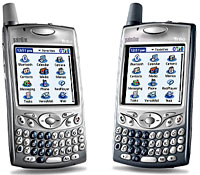 Following on from Part One, published last week.
Following on from Part One, published last week.
The design
As its rivals continue their crash diets and squeeze into ever-smaller designs, there’s no doubt that the Treo’s beginning to look like a bit of a lardy boy these days (although it’s by no means the biggest smartphone out there).
Of course, one of the problems with smartphones is that if you try and shrink them too much, usability flies out of the window.
Smartphones, by definition, need a big bright screen to fit all the information in (and at 320 x 320 pixels, the Treo’s got one of the largest displays around) and there’s a human limit to how small you can make a keyboard.
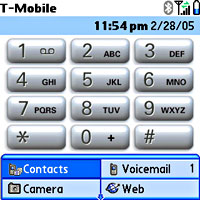 Keyboards. Soft vs hard (ooo-er)
Keyboards. Soft vs hard (ooo-er)
Some smartphone makers have tried to get around this limitation by getting rid of the keyboard altogether and using an onscreen ‘soft’ keyboard instead.
Although this allows designers to make super-small smartphones, the lack of a proper keyboard is – to quote Clint Eastwood – some price to pay for being stylish.
Soft keyboards are absolutely horrible to use. Apart from the fact that your screen rapidly turns into a smudgy mess, they’re simply not as effective as a proper hardware keyboard, and after using both, we’d certainly never again invest in a smartphone without a proper keypad.
Other features
Despite its ‘built for comfort’ shape, the Treo still feels pretty good in the hand, with some of the best ergonomics around – changing the SIM card, for example is an absolute breeze compared to most phones (just use the slide out tray, accessible from the top of the phone), and it’s the same story for the SD card.
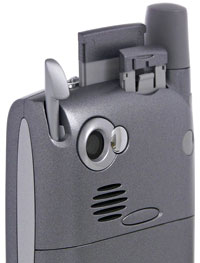 Volume controls are where they should be – on the side of the phone – and muting the phone entirely is simply a case of sliding a switch in the top of the phone, a feature that is inexcusably absent in almost every other phone.
Volume controls are where they should be – on the side of the phone – and muting the phone entirely is simply a case of sliding a switch in the top of the phone, a feature that is inexcusably absent in almost every other phone.
It’s not all good though, with the Palm designers needlessly forcing users to take off the back of the phone whenever a reset is needed.
And then there’s that great, chunky monolith of an antenna that’s bolted on to the phone. Funnily enough, it seems that most Americans actually like antennas on their handsets, but we can’t say we’re too keen.
The phone bit
Of course, pretty looks and bright screens are one thing, but it’s how the thing works as a phone that matters most and here’s where the Treo excels.
When someone new calls you up, a great big button comes onscreen at the end of the call asking you if you want to add the number in your phonebook. Simple. Straightforward. Obvious.
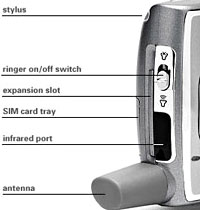 If you want to switch to the speakerphone during a call, just press the ruddy great onscreen ‘speakerphone’ icon. No holding down keys, no shuffling about in sub-menus or fiddling about with switches like a Windows phone.
If you want to switch to the speakerphone during a call, just press the ruddy great onscreen ‘speakerphone’ icon. No holding down keys, no shuffling about in sub-menus or fiddling about with switches like a Windows phone.
If you want to see who’s called you, just press the green call button twice and a list of calls comes up.
As you scroll down the list, context sensitive buttons appear, asking if you’d like to add the unknown numbers to your contacts, or if you’d like to send a SMS message to known contacts.
Click on a name and it calls them. Click on ‘call log’ and you’ll get a comprehensive listing of every phone call you’ve made, categorised into ‘incoming,’ ‘missed’ and ‘outgoing.’
If you want to find out more, click on ‘details’ and you’ll get the exact time and duration of the call.
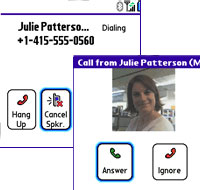 Looking someone up in the address book is just as simple – just type in their initials and you’ll go straight to their entry.
Looking someone up in the address book is just as simple – just type in their initials and you’ll go straight to their entry.
The whole phone is designed for effortless one handed operation, meaning you can use the phone on the move while most Windows Mobile users will be left reaching for their itty-bitty stylus or fiddling about with slide-out keyboards or ‘soft’ onscreen keyboards.
Get ’em quick before they go!
Note: since we started this piece, Palm have announced that there will be no further European shipments of Treo 650s as the phone breaches new EU regulations.
However, the company claims that it has already sent enough Treo 650s to meet demand for now, although US users can already indulge themselves with the newly released Treo 700p offering EVDO.
 Palm has said that its next Treo smartphone will be targeted at European markets, although it appears that it won’t be a GSM/UTMS version of the 700p.
Palm has said that its next Treo smartphone will be targeted at European markets, although it appears that it won’t be a GSM/UTMS version of the 700p.
Instead, Palm are rumoured to be developing an antenna-less Treo for the European market, possibly to be called the Treo Nitro (thanks to the valued reader who pointed this out to us – you know who you are).
Palm CEO Ed Colligan has suggested that the new model is unlikely to become available until Palm’s 2nd Quarter in FY 2007 (around October – December 2006).
Readers sufficiently enthused by our comments should look on eBay where there are ample new and reconditioned Treo 650’s available for between £170-£280 (that’s where we got ours from!).
Coming up in part three: Palm Treo multimedia and office apps.
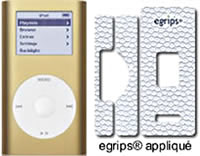 Are you the owner of a pair of super slippery hands that seem unable to keep a firm grip on your mobile or PDA?
Are you the owner of a pair of super slippery hands that seem unable to keep a firm grip on your mobile or PDA? 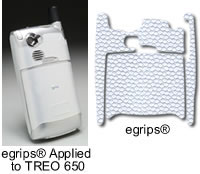 We’re not sure what the Frenchy-sounding name is all about, but the company offers a range of protective stick-on covers for a wide selection of electronic devices such as cell phones, PDAs, digital cameras, iPods, MP3 players, gaming devices etc.
We’re not sure what the Frenchy-sounding name is all about, but the company offers a range of protective stick-on covers for a wide selection of electronic devices such as cell phones, PDAs, digital cameras, iPods, MP3 players, gaming devices etc.  Made from a super thin material, the makers claim that the “specially formulated adhesive” won’t damage your precious gadget while the super-grippy material will prevent it from, “sliding around on dry surfaces, like car seats, centre consoles, counter tops, desktops, laptops and more.”
Made from a super thin material, the makers claim that the “specially formulated adhesive” won’t damage your precious gadget while the super-grippy material will prevent it from, “sliding around on dry surfaces, like car seats, centre consoles, counter tops, desktops, laptops and more.” 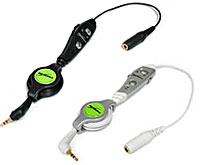 If you’re fed up with having to use the rubbish headphones that came with your Treo, you may want to consider investing in BoxWave’s Dual Handsfree Stereo Adapter.
If you’re fed up with having to use the rubbish headphones that came with your Treo, you may want to consider investing in BoxWave’s Dual Handsfree Stereo Adapter. 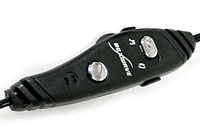 The unit features a simple (gold plated) 2.5mm to 3.5mm adapter which connects up to a small control unit which includes an integrated microphone, single-touch answer call button, volume control, and a switch for toggling between music and handsfree phone mode.
The unit features a simple (gold plated) 2.5mm to 3.5mm adapter which connects up to a small control unit which includes an integrated microphone, single-touch answer call button, volume control, and a switch for toggling between music and handsfree phone mode. 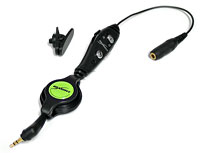 Giving it a bit of welly with some MP3s played back on
Giving it a bit of welly with some MP3s played back on 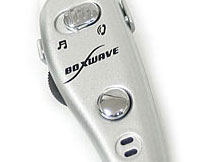 Overall, we found the BoxWave to be well worth the outlay (currently on offer from their site at $20.95) and a great investment if you want to be able to get the best music performance out of your Palm Treo 650/700p/700w.
Overall, we found the BoxWave to be well worth the outlay (currently on offer from their site at $20.95) and a great investment if you want to be able to get the best music performance out of your Palm Treo 650/700p/700w. 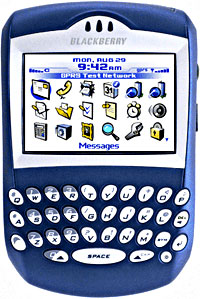 Like the Black Knights in Monty Python’s ‘Holy Grail,’ PDAs are refusing to be beaten, despite almost monthly declarations of their impending obsolescence.
Like the Black Knights in Monty Python’s ‘Holy Grail,’ PDAs are refusing to be beaten, despite almost monthly declarations of their impending obsolescence.  This explains how worldwide PDA end-user revenue fell by 4.1 percent last year to $1.38 billion in the second quarter of 2006.
This explains how worldwide PDA end-user revenue fell by 4.1 percent last year to $1.38 billion in the second quarter of 2006. 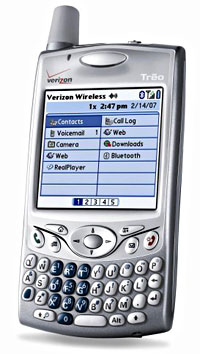 For a self confessed, gimme-gimme-shiny-new gadgets nutcase like me to be using a phone several years old speaks volumes of the strengths of the Treo 650.
For a self confessed, gimme-gimme-shiny-new gadgets nutcase like me to be using a phone several years old speaks volumes of the strengths of the Treo 650. 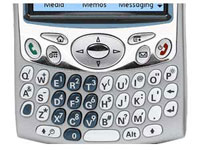 If I’d have taken my Windows Mobile phone I dare say I would have been very well acquainted with stylus (and the reset button) by this time, but the Treo’s fabulous one-handed operation and rock solid performance made it a practical laptop replacement.
If I’d have taken my Windows Mobile phone I dare say I would have been very well acquainted with stylus (and the reset button) by this time, but the Treo’s fabulous one-handed operation and rock solid performance made it a practical laptop replacement. 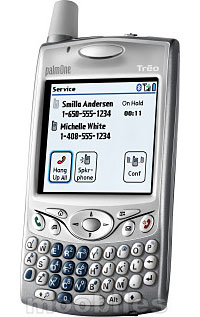 Palm has remained tight-lipped about their European product roadmap, with the web rife with rumours of both Windows and Palm new models going under ggroovy codenames like Hollywood, Lowrider, Nitro and Lennon.
Palm has remained tight-lipped about their European product roadmap, with the web rife with rumours of both Windows and Palm new models going under ggroovy codenames like Hollywood, Lowrider, Nitro and Lennon. 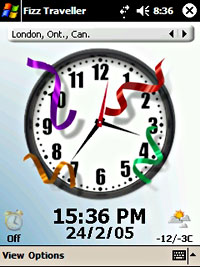 Wedging its foot firmly into the territory currently ruled by rival application World Mate, Fizz Traveller for Pocket PC is a mobile travel companion, compatible with Windows Mobile 2003/2005 and Smartphone editions.
Wedging its foot firmly into the territory currently ruled by rival application World Mate, Fizz Traveller for Pocket PC is a mobile travel companion, compatible with Windows Mobile 2003/2005 and Smartphone editions.  Great if you like that kind of thing, of course, but we’d be happier with just one clean, crisp and professional interface than a load of bubbly, baubly spinning things.
Great if you like that kind of thing, of course, but we’d be happier with just one clean, crisp and professional interface than a load of bubbly, baubly spinning things. 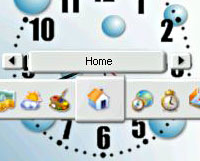 Sadly, you couldn’t zoom into the map so it wasn’t the greatest of travel aids.
Sadly, you couldn’t zoom into the map so it wasn’t the greatest of travel aids. 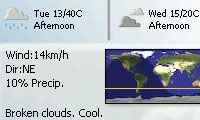 We liked the weather maps and there’s no denying that the interface has been buffed and polished up to a very high standard with lots of options for folks who like to customise their app.
We liked the weather maps and there’s no denying that the interface has been buffed and polished up to a very high standard with lots of options for folks who like to customise their app.  Here’s the third in Mike’s three part review of why the Palm Treo rocks his boat.
Here’s the third in Mike’s three part review of why the Palm Treo rocks his boat.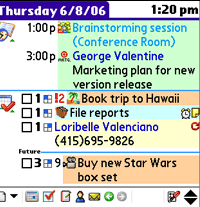 Word!
Word! It’s the same story with SMS, with the built in text messaging interface on the Palm remaining streets ahead of its Pocket PC rivals, with the superb auto-threading conversations making it easy to keep track of text conversations. It really is a delight to use.
It’s the same story with SMS, with the built in text messaging interface on the Palm remaining streets ahead of its Pocket PC rivals, with the superb auto-threading conversations making it easy to keep track of text conversations. It really is a delight to use.  Anyone who enjoyed Mario Kart on the Nintendo SNES back in the 90s will love MicroQuad by Viex Games.
Anyone who enjoyed Mario Kart on the Nintendo SNES back in the 90s will love MicroQuad by Viex Games.  At the beginning of each game you can select any one of six different bikes, each offering different strengths and weaknesses (road, off road and grip).
At the beginning of each game you can select any one of six different bikes, each offering different strengths and weaknesses (road, off road and grip).  The game also offers an internet high score competition, a Bluetooth multiplayer option and a ‘Quick Race’ option if you fancy a quick blast around the tracks.
The game also offers an internet high score competition, a Bluetooth multiplayer option and a ‘Quick Race’ option if you fancy a quick blast around the tracks.  Following on from
Following on from  Keyboards. Soft vs hard (ooo-er)
Keyboards. Soft vs hard (ooo-er) Volume controls are where they should be – on the side of the phone – and muting the phone entirely is simply a case of sliding a switch in the top of the phone, a feature that is inexcusably absent in almost every other phone.
Volume controls are where they should be – on the side of the phone – and muting the phone entirely is simply a case of sliding a switch in the top of the phone, a feature that is inexcusably absent in almost every other phone.  If you want to switch to the speakerphone during a call, just press the ruddy great onscreen ‘speakerphone’ icon. No holding down keys, no shuffling about in sub-menus or fiddling about with switches like a Windows phone.
If you want to switch to the speakerphone during a call, just press the ruddy great onscreen ‘speakerphone’ icon. No holding down keys, no shuffling about in sub-menus or fiddling about with switches like a Windows phone.  Looking someone up in the address book is just as simple – just type in their initials and you’ll go straight to their entry.
Looking someone up in the address book is just as simple – just type in their initials and you’ll go straight to their entry.  Palm has said that its next Treo smartphone will be targeted at European markets, although it appears that it won’t be a GSM/UTMS version of the 700p.
Palm has said that its next Treo smartphone will be targeted at European markets, although it appears that it won’t be a GSM/UTMS version of the 700p. 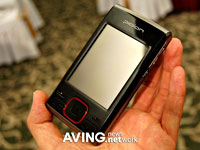 No relation to the fabulous football team known as the Bluebirds, the Korean electronics company Blue Bird have announced their shiny new BM-300 T-DMB Personal Digital Assistant (PDA).
No relation to the fabulous football team known as the Bluebirds, the Korean electronics company Blue Bird have announced their shiny new BM-300 T-DMB Personal Digital Assistant (PDA). 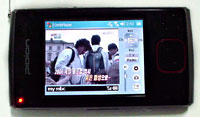 Although the 2.8 inch touchscreen TFT-LCD (QVGA) display looks like a bit of a whopper, it can only support a miserly 240 x 320 pixel resolution -a bit of a disappointment for a PDA and hardly likely to enhance the TV watching experience,
Although the 2.8 inch touchscreen TFT-LCD (QVGA) display looks like a bit of a whopper, it can only support a miserly 240 x 320 pixel resolution -a bit of a disappointment for a PDA and hardly likely to enhance the TV watching experience,  Memory can be further expanded via an SD SDIO card slot.
Memory can be further expanded via an SD SDIO card slot. 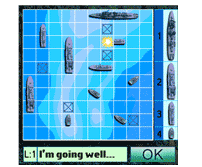 Some of the most compelling games are often the simplest, and games don’t get much more basic than the age-old game of Battleships.
Some of the most compelling games are often the simplest, and games don’t get much more basic than the age-old game of Battleships. 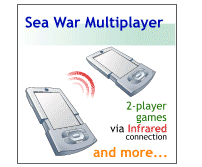 If you miss, you get a splashy sound (and quite possibly the derision of your chum across the room) and if you hit the target you get a gratifying kaboom (with the option to shout and jeer at your opponent’s misery).
If you miss, you get a splashy sound (and quite possibly the derision of your chum across the room) and if you hit the target you get a gratifying kaboom (with the option to shout and jeer at your opponent’s misery). 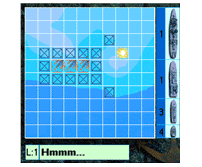 Our opinion
Our opinion